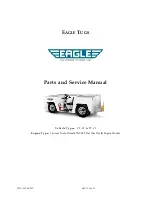
Fig. 3
4.1
The operating handle control lever (1) can be set to one of three positions, as shown in Fig. 3.
Positions are:
4.1.1
RAISE:
Control lever in the DOWN position.
4.1.2
DRIVE:
Control level in the CENTRAL position.
4.1.3
LOWER:
Control lever in the UP position.
4.2
If the above positions have been altered, they can be restored by carrying out the following
adjustments.
IMPORTANT: The numbers in Fig. 4 are designated by oval brackets. The number in Fig. 5
is designated by square brackets.
4.2.1 If the forks rise whilst pumping in the
DRIVE
position, turn the adjusting nut (2) on the adjusting
bolt (3) or the adjusting screw [1]
clockwise,
until the pumping action does not raise the forks
and the
DRIVE
position functions normally.
4.2.2 If the forks lower whilst pumping in the
DRIVE
position, turn the adjusting nut (2) or the adjusting
screw [1]
counterclockwise,
until the pumping action does not lower the forks.
4.2.3 If the forks do not lower when the control lever is in the
LOWER
position, turn the adjusting nut
(2) or the adjusting screw [1]
clockwise,
until raising the control lever lowers the forks.
NOTE:
Check the
DRIVE
position again by repeating paragraphs 4.2.1 and 4.2.2 to ensure that the
adjusting nut (2) and the adjusting screw [1] are still in the correct position.
4.2.4 If the forks do not rise when pumping in the
RAISE
position, turn the adjusting nut (2) or the
screw [1]
counterclockwise
until the forks rise whilst pumping in this position.
NOTE:
Check the
LOWER
and
DRIVE
positions again from paragraphs 4.2.1 to 4.2.3 to ensure that the
LOWER
and
DRIVE
positions are functioning correctly.
4. CONTROL ADJUSTMENT
5. OPERATION
5.1
Operating the Pallet Truck
WARNING! An operator must be fully conversant with the safety instructions at Section 1.
5.1.1 Prior to operating the pallet truck, check the wheels, the operating handle and the fork unit to
ensure they are fit for purpose.
5.1.2 Move the truck with the operating handle control lever in the
DRIVE
position, as this makes the
operating handle easier to move and also depressurises the hydraulic pump.
DO NOT
overload
the pallet truck.
NOTE:
The stated capacity of the truck assumes an evenly distributed load with the centre of the load
located half way along the length of the forks.
5.1.3 Ensure that the goods being transported are placed on the middle of the pallet truck forks.
Refer to Fig. 6.
Fig. 6
Fig. 4
Fig. 5
6. MAINTENANCE
6.1
Daily Maintenance Check
6.1.1 Check the state of the wheels and the axles since thread, rags and other foreign objects can jam
the wheels making safe, effective operation difficult.
6.1.2 On completion of each task, unload the forks and return them to the lowest position.
6.2
Oil Check
6.2.1 Check the oil level at six monthly intervals. Sealey hydraulic jack oil is used with the pallet truck.
The viscosity of the oil should be 30cSt at 40°C. The amount used in the pallet truck is
approximately 0.3 litres.
6.3
Lubrication
6.3.1 Use motor oil or grease to lubricate all moveable parts.
6.4
Purging Air
from the Hydraulics
6.4.1 Air can get into the hydraulic oil through transportation, or the pump becoming misaligned. As a
result, the forks will not elevate.
6.4.2 The air can be purged by setting the operating handle control lever, (1) in Fig. 4, to the
LOWER
position and pumping the operating handle up and down for a few seconds.
6.4.3 When the pallet truck is not in use, lower the forks and park the truck where it will not be a
hazard.
Original Language Version
PT1150LD Issue: 2 - 04/11/09












